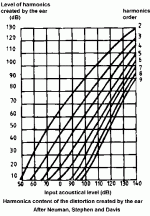Interesting.
In the old days I used to apply a fundamental nulling sinewave an observe the difference; this also revealed crossover distortion.
What would the errors these waveforms 'carry' look like when the fundamental is removed. Also, how will this tie in with computer generated analysis ??
Cheers ......... Graham.
In the old days I used to apply a fundamental nulling sinewave an observe the difference; this also revealed crossover distortion.
What would the errors these waveforms 'carry' look like when the fundamental is removed. Also, how will this tie in with computer generated analysis ??
Cheers ......... Graham.
jeff mai said:I posted this on another thread, but it may get more discussion here.
http://www.gedlee.com/distortion_perception.htm
In particular check out the second power point presentation. It has most of the details.
Apparently it's all about masking ...
Interesting website. The authors (?) of the site seem to reconfirm long-published notions that "distortion spectrum" (not so much the level but the shape of a given distortion curve) is the important variable in understanding the subjective perception of distortion, at least so far as harmonic distortion is concerned.
Moving to a larger veiw of things, I question whether we have even a workable understanding of "distortion." Air, by its very properties, (and presumably any physical medium) "distorts" sound passing through it. Sound is therefore "distorted" by its nature, and nobody's ever heard "undistorted" sound. The ear, for its part, takes already distorted sound and distorts it further. So far as I understand, air and the ear distort sound in almost the very manner a 300B tube does.
But j'digress.
mashaffer said:
While musing on these things it occured to me that our mathimatical model of harmonic distortion may not be the best way to characterise distortion. I would like your input on the following theory.
I am suggesting that it is possible that a visual correlation of the distorted waveform v.s. the pure input signal may be a more accurate indiactor of audible distortion than a power series representation of distortion products.
In other words if the distortion of a wave shape looks gross will it then sound that way while a distortion which appears sublte on the scope will also be unobtrusive to the ear?
Interesting thought. I've been thinking of similar issue over the past decade.
You mention distortion in a power spectrum, but something that I've seen very little information about is the phase of the harmonics of that particular spectrum. No one seems to pay attention of the time that each signal arrives at the ear. I would tend to think that phase could play a major role in the distortion.
I've done some simple experiments in my shop, replacing external miller capacitance with progressively larger values, listening to the changes carefully. I also had my wife listening, but kept her unaware of the changes. We both preferred the amplifier when set up for constant group delay (or linear phase, depending on your school of thought). Anything more than a few tens of degrees at 20Khz, and the effect at lower frequencies was horrible, even though the sinusoidal amplitude changes were undetectable on a scope. The sound was muddied, or dulled, even though it was detailed.
Also, testing of the low frequency cutoff, where similar phase changes were tried, ended with similar results.
I'm thinking that musical instruments with very wide audio bandwidths suffer the most. Think of hitting a chord on guitar, with harmonics possibly entering upper and lower frequency cutoffs. (I seem to remember that phase shifts start a decade above or below fc.) This would mean the the actual pressure waveform reaching the ear would be distorted, even though the same amplitude harminics reach the ear.
In the end, for my design chose to give up considerable noise specification, for increased linear phase and bandwidth response. Increases of 10 or more dB in signal to noise ratio (3Hz ro 200Khz), resulted in better linear phase response and a crisper sound. I even implemented pole splitting techniques, loosing stability at 1Mhz. This also showed marked improvement at the listening end... ...after all none of my CD sources generate 1Mhz...
Interesting thoughts. I may have to make some wave files with differing amplitudes of distortion, to see which appeals to my wife and my self...
-Dan
P.S. Millwood, are your images 3rd order, only differing by phase??? (Not sure, but that's my gut feeling)
- Status
- This old topic is closed. If you want to reopen this topic, contact a moderator using the "Report Post" button.
